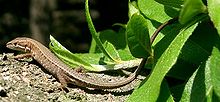Takydromus tachydromoides
Appearance
| Takydromus tachydromoides | |
|---|---|

| |
| Scientific classification | |
| Domain: | Eukaryota |
| Kingdom: | Animalia |
| Phylum: | Chordata |
| Class: | Reptilia |
| Order: | Squamata |
| Family: | Lacertidae |
| Genus: | Takydromus |
| Species: | T. tachydromoides
|
| Binomial name | |
| Takydromus tachydromoides (Schlegel, 1838)
| |
Takydromus tachydromoides, the Japanese grass lizard, is a wall lizard species of the genus Takydromus. It is found in Japan. Its Japanese name is 'kanahebi' (カナヘビ). 'Hebi' means 'snake' in Japanese, although this lizard is not a snake. There are three species of lizards found on the four main islands of Japan. The other two are the Japanese gekko (also known as Schlegel's Japanese gekko, Gekko japonicus ,or 'yamori' (ヤモリ) in Japanese) and the Okada's Five-lined Skink (Eumeces latiscutatus, also Plestiodon latiscutatus; the five lines on its back are only visible in its juvenile form).[1]


Live food
References
Wikimedia Commons has media related to Takydromus tachydromoides.
Wikispecies has information related to Takydromus tachydromoides.
- ^ Kevin Short, Nature in Tokyo, Kodansha, 2000

